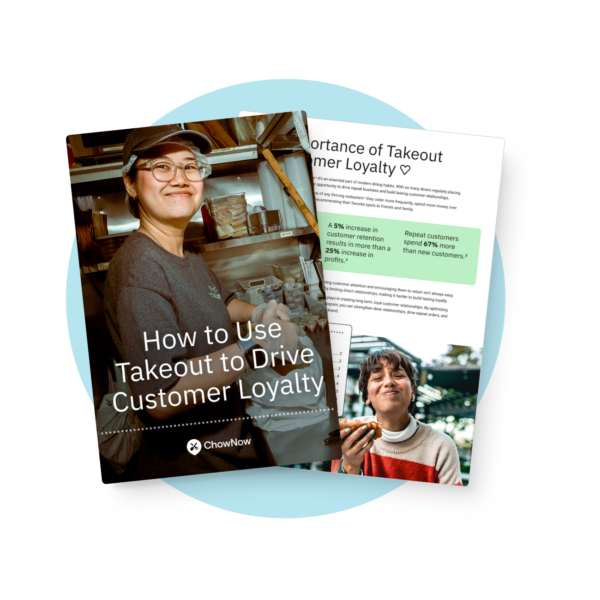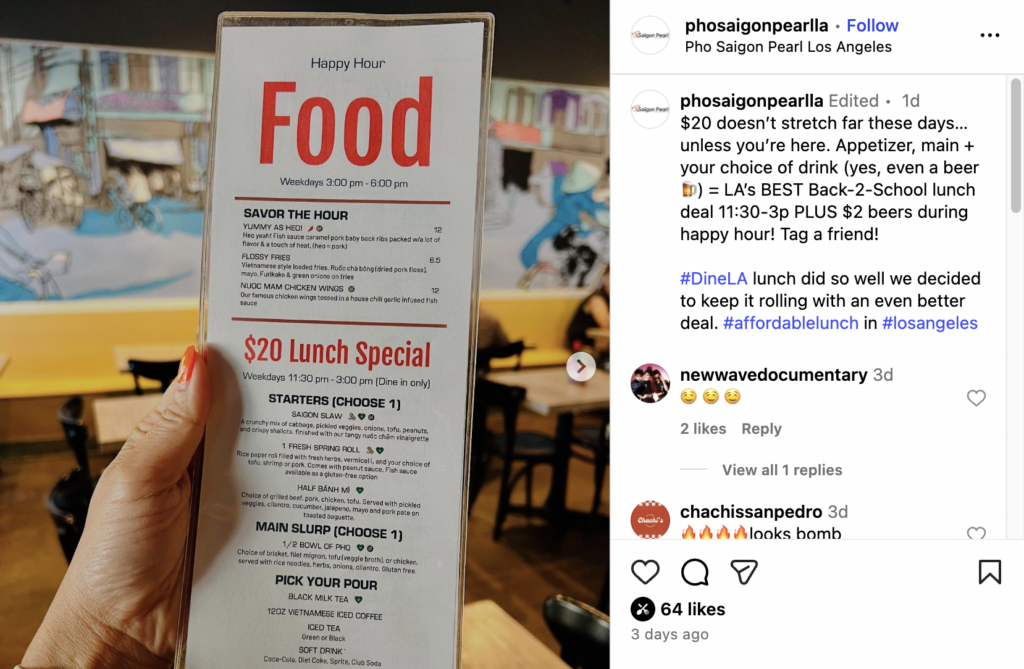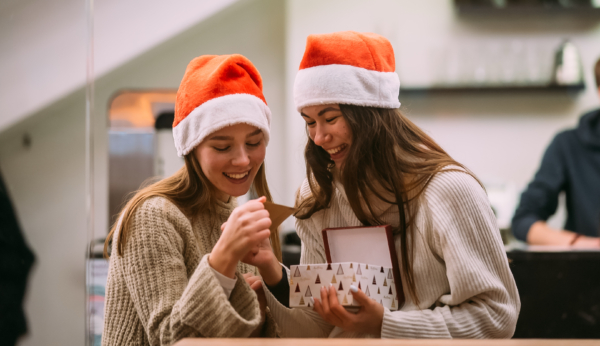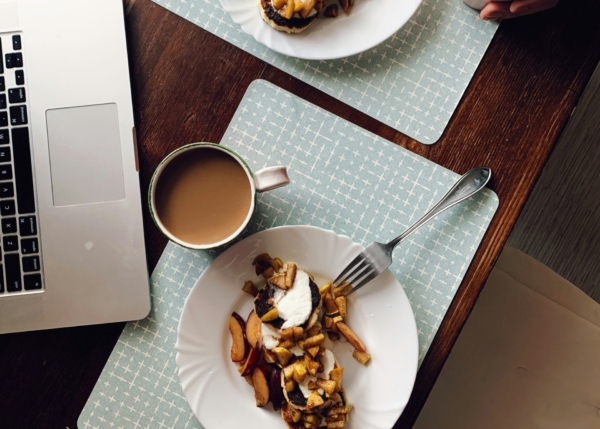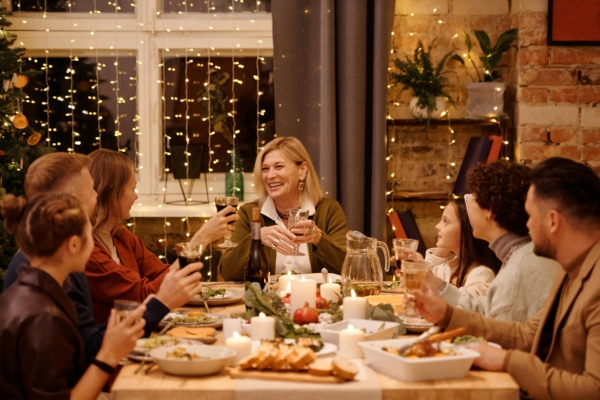Restaurant Social Media Calendar: How to Plan Posts That Drive Orders

If you’ve been reading up on restaurant social media, you’ve probably noticed a recurring theme: the key to social media marketing success is consistency.
Knowing this and executing it, though, are two completely different things.
It’s not enough to take a picture of your special, post it on Instagram, then cross it off your to-do list—even if you are posting consistently.
For your social media posts to actually drive results, they need to tie back to real marketing goals, such as increasing online ordering or growing your loyalty program signups.

That combination—consistency plus goal-driven content—requires a plan. And the best way to create and execute that plan is with a restaurant social media calendar.
In this article, you will learn:
- How to align posts with promotions, menu drops, and loyalty campaigns
- A proven strategy for balancing community and promotional social media content
- Tools and tips to organize, schedule, and repurpose your highest-performing posts
Let’s break down how to build a calendar that turns posts into orders.
Define Your Goals and Map Key Dates
Before you start filling in your content calendar with random post ideas, take a step back and define what you want your social media marketing to accomplish.
Are you trying to drive more online ordering through your restaurant website or app?
Fill the dining room on slower nights?
Build loyalty among regulars?
Your restaurant’s social media strategy should support these bigger business goals—not just fill up your feed.
Start by choosing 1-2 primary goals that your posts should ladder up to, such as:
- Driving direct orders
- Promoting special events or menu items
- Growing your loyalty program or email list

Next, map out the key dates that matter most to your restaurant business. These can include:
- Menu launches, limited-time offers, or seasonal specials
- Holidays like Father’s Day, Memorial Day, or Earth Day
- Local events like food festivals, live music, or sporting events
And don’t forget to consider who you’re talking to with each post. Defining simple audience personas, like couples looking for a casual weeknight dinner, or sports fans searching for a place to grab fast eats and beer after a big game, can help guide both your messaging and your visuals.
That way, every post feels like it’s speaking directly to the right customers.
Balance Your Content Mix
One of the biggest mistakes restaurant owners make on social media is treating it like a digital bulletin board—only posting specials, discounts, and promotions.
While those posts are important, they’re not enough to build a loyal following. To engage people, you need a healthy mix of content that both engages and sells.
Take the 80/20 approach
The 80/20 approach means about 80% of your social media posts should focus on community, storytelling, and entertainment, while the other 20% should directly drive sales, like promotions and discounts.

Community content ideas
Community-driven posts help give your restaurant a personality and make your brand more relatable. Try ideas, like:
- Staff spotlights and behind-the-scenes moments
- Collaborations with local businesses
- Educational posts about ingredients or cooking techniques
- Customer highlights, like a photo of their favorite dish
View this post on Instagram
Promotional content ideas
Promotional posts connect directly to your marketing efforts and help boost sales.
Examples include:
- Direct links to your online ordering page
- Announcements for new menu items or special events
- Loyalty program reminders and sign-up prompts
- Limited-time offers tied to major holidays or seasonal specials
Why balancing your content matters
People use social media for entertainment, not nonstop discounts and promotions.
Giving your audience fun, engaging restaurant social media content is what draws customers in and builds a connection with your brand. That way, when they do see a promotion or discount, they’re ready to take action.
Plan Weekly Themes That Keep You Consistent
Consistency gets a lot easier when you give yourself a structure to follow. Instead of scrambling to figure out what to post each day, use weekly themes to guide your content.
Think of them like “content buckets” you can return to again and again.
Assign themes to days of the week
You don’t need to post every day, but having regular slots makes planning simple.
For example:
- Monday: Menu spotlight (highlight a dish or cocktail with a great photo)
- Wednesday: Customer review or user-generated content
- Friday: Behind-the-scenes or staff spotlight
- Sunday: Rewards or loyalty reminder
By giving each day a clear purpose, you’ll never sit staring at a blank screen wondering what to post—and to make it even easier, we’ve put together a Day-by-Day Guide to Content Ideas to get you started.
Recommended posting

Every platform is different, but here’s a solid starting point:
- Instagram: 2-4 times per week, plus 2-3 stories
- Facebook: 2-4 times per week
- TikTok: 3-5 videos per week (short and fun)
This might look overwhelming at first, but remember that Instagram and Facebook are both owned by Meta, which has a feature you can enable called Crossposting. Once turned on, whatever you post on one social media platform will automatically be posted to your other platform account, saving you considerable time and effort.
Leave room for the unexpected
Always leave space for trending topics, timely updates, or spontaneous moments—like a staff celebration, a last-minute live music night, or even a funny team moment can be some of your most engaging content. Building this kind of flexibility into your calendar makes planning easier and more effective.
Use Tools To Streamline Your Workflow
Trying to build every post from scratch would be overwhelming and inefficient. You can avoid this by organizing your content in advance with the right tools.
Choose a planning tool that fits your needs
For most restaurant owners, a simple and free Google Sheet is the perfect way to organize and share content with your team, but if you need software that gives you visual boards, try:
- Trello: Drag-and-drop cards for each post, great for teams
- Asana: Ideal for task assignments and deadlines
What matters most is having one central place to map out posts, deadlines, and responsibilities so nothing slips through the cracks.
Organize photos, captions, and links
Don’t wait until the morning of a post to scramble for a photo or write a caption. Batch your work by creating and organizing content ahead of time.
One of the best ways to stay prepared is to build a shared visual asset library—using tools like Google Drive, Dropbox, or Canva folders.
Your library can include:
- High-quality shots of your menu items
- Behind-the-scenes (BTS) photos and videos of your team
- User-generated content (UGC) from happy customers
Having this ready-to-go library means anyone on your team can quickly pull a polished image or video without digging through phones or hard drives at the last minute.
Automate posting when you can
If you want to save even more time, consider a scheduling tool like Buffer, Later, or Meta Business Suite.
These platforms let you set up posts in advance so your feed stays active—even on your busiest nights.
Tie Every Post To A Sales Driver
Even though 80% of your content should be community-driven, you still need to encourage followers to take some kind of action, whether that’s placing an order through your website, making a reservation, or downloading your mobile app.
Here’s how to do that.
Add links and clear calls to action
Whenever you share a new menu item, highlight a seasonal special, or promote your loyalty program, include a clear next step. That could be:
- A direct link to your online ordering page
- A “Sign up now” button for your rewards program
- A reminder to order ahead for pickup or delivery
Don’t assume customers know what to do next—make the path from your post to action as easy as possible.

Repurpose content that already works
Not every post will be a home run, but when you find one that performs especially well, repurpose it. For example:
- Turn a popular Instagram Reel into a TikTok video
- Re-share a high-engagement photo on Facebook with updated copy
- Use snippets from a successful video as Instagram Stories
Like Simpang Asia—they took a top-performing Instagram Reel about their signature dish and gave it new life by reposting it to TikTok. Same content, different format, and new reach
Recycling proven content not only saves time, it also extends the lifespan of posts that already resonate with your audience.
@simpangasiawho says sauteeing isn’t a 3 man job? #SimpangAsia #food #foodporn #LAeats #asianfood #indonesianfood #losangeles #lafoodie #laeater #thingstodoinla #IndofoodLA♬ original sound – Simpang Asia
View this post on Instagram
Connect posts to bigger goals
Think of each post as part of a larger strategy. For example, if your goal for the month is 100 new loyalty program signups, align all your content around that.
Non-promo posts can include captions like “Sign up now,” while videos can end with “Hit the link in our bio to get rewards.” Promo posts might sweeten the deal with 5% off or a free drink after signing up.
When every post works toward the same goal, your social media becomes more than brand awareness—it turns into an engine for growth.
Track Performance And Adjust Your Plan
Your social media marketing should never be static—it evolves as you learn what resonates with your audience. Posting consistently is only half the job; tracking results and adjusting your plan is what makes your efforts sustainable.
Monitor the right metrics
Don’t obsess over vanity metrics like likes—focus on signals that connect back to your goals.
Pay attention to these metrics:
- Engagement: comments, shares, and saves (do people care enough to interact?)
- Clicks: traffic driven to your ordering page, menu, or loyalty sign-up
- Orders: volume of direct orders that originated from social posts
These numbers will tell you whether your posts are just getting attention—or actually driving sales.
Use insights to refine your strategy
Most social media platforms offer free analytics that show which posts performed best.
If certain post types consistently underperform, swap them out. If your followers love behind-the-scenes videos but rarely click on text-only posts, lean into what works.
You might even discover opportunities to increase frequency on one platform while scaling back on another.
Keep experimenting with your content
Don’t be afraid to try out and test new formats like Stories, Reels, or live video. If you find your audience engages more with employee highlight reels than traditional menu item posts, adjust accordingly.
The goal is to keep your content fresh and flexible while staying focused on the goals you set at the start.
Keep Your Social Media Calendar Focused on Results
Consistency is critical to your social media marketing success, but by using a content calendar, you can ensure your content is helping you reach your larger goals to drive sales and growth.
With the right plan in place, every post becomes an opportunity to connect with your audience and move your restaurant forward.
Contact ChowNow to learn how you can direct diners to a Direct Online Ordering System using social media.
Restaurant Social Media Calendar Frequently Asked Questions
How far ahead should I plan my restaurant’s social media calendar?
Plan your social media calendar a month in advance or 4 to 6 weeks in advance. This gives you time to prepare content around promotions, seasonal menu items, and holidays, while still leaving room for last-minute opportunities or trending topics.
What’s the best way to handle last-minute changes or promotions?
Keep your calendar flexible by using scheduling tools. If you need to adjust for a surprise event or sold out menu item, simplyswap in new content.. Scheduling tools make this easy by letting you drag and drop posts without re-doing your entire schedule..
How do I know if my calendar is working?
Measure results by tracking engagement, clicks, and orders. If your posts drive customers to place online orders, join your loyalty program, or engage with your restaurant, you’ll know your calendar is aligned with your business goals.
Should I post the same content on all platforms?
No—adapt content for each platform. You can repurpose the same idea, but tailor it for each platform. For example, a 15-second video may perform best on TikTok, while a customer spotlight photo might do better on Facebook or Instagram.
How do I keep my content from feeling repetitive?
Avoid repetition by mixing up the types of posts you share. Highlight different parts of your menu, showcase customer reviews, give followers a behind-the-scenes look, and promote special offers. Mixing in user-generated content and seasonal specials also helps keep your feed fresh and engaging.
